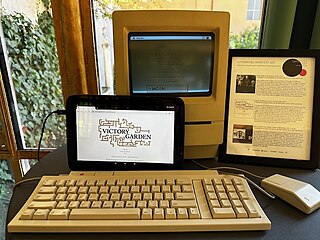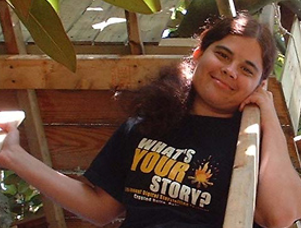Hypertext fiction is a genre of electronic literature characterized by the use of hypertext links that provide a new context for non-linearity in literature and reader interaction. The reader typically chooses links to move from one node of text to the next, and in this fashion arranges a story from a deeper pool of potential stories. Its spirit can also be seen in interactive fiction.

"The Garden of Forking Paths" is a 1941 short story by Argentine writer and poet Jorge Luis Borges. It is the title story in the collection El jardín de senderos que se bifurcan (1941), which was republished in its entirety in Ficciones (Fictions) in 1944. It was the first of Borges's works to be translated into English by Anthony Boucher when it appeared in Ellery Queen's Mystery Magazine in August 1948. In 1958 it was translated back into English by Donald A. Yates and published in Michigan Alumnus Quarterly Review, Spring 1958. In 1962 this translation was included in the book Labyrinths.
Michael Joyce is a retired professor of English at Vassar College, New York, US. He is also an important author and critic of electronic literature.
Electronic literature or digital literature is a genre of literature where digital capabilities such as interactivity, multimodality or algorithmic text generation are used aesthetically. Works of electronic literature are usually intended to be read on digital devices, such as computers, tablets, and mobile phones. They cannot be easily printed, or cannot be printed at all, because elements crucial to the work cannot be carried over onto a printed version.
Edward Falco is an American author, playwright, electronic literature writer, and new media editor.

afternoon, a story, spelled with a lowercase 'a', is a work of electronic literature written in 1987 by American author Michael Joyce. It was published by Eastgate Systems in 1990 and is known as one of the first works of hypertext fiction.
George Paul Landow was Professor of English and Art History Emeritus at Brown University. He was a leading authority on Victorian literature, art, and culture, as well as a pioneer in criticism and theory of Electronic literature, hypertext and hypermedia. He also pioneered the use of hypertext and the web in higher education.

Patchwork Girl or a Modern Monster by Mary/Shelly and Herself is a work of electronic literature by American author Shelley Jackson. It was written in Storyspace and published by Eastgate Systems in 1995. It is often discussed along with Michael Joyce's afternoon, a story as an important work of hypertext fiction.

Victory Garden is a work of electronic literature by American author Stuart Moulthrop. It was written in Storyspace and first published by Eastgate Systems in 1991. Victory Garden is one of the earliest examples of hypertext novels, and is notable for being very inventive and influential in its genre. It is often discussed along with Michael Joyce's afternoon, a story as an important work of hypertext fiction.
Jay David Bolter is the Wesley Chair of New Media and a professor in the School of Literature, Media, and Communication at the Georgia Institute of Technology. His areas of study include the evolution of media, the use of technology in education, and the role of computers in the writing process. More recently, he has conducted research in the area of augmented reality and mixed media. Bolter collaborates with researchers in the Augmented Environments Lab, co-directed with Blair MacIntyre, to create apps for entertainment, cultural heritage and education for smart phones and tablets. This supports his theory regarding remediation where he discusses "all media functions as remediators and that remediation offers us a means of interpreting the work of earlier media as well".

Jane Yellowlees Douglas is a pioneer author and scholar of hypertext fiction. She began writing about hypermedia in the late 1980s, very early in the development of the medium. Her 1993 fiction I Have Said Nothing, was one of the first published works of hypertext fiction.
Eastgate Systems is a hypertext publisher and software company headquartered in Watertown, Massachusetts.
Sarah Smith is an American author living in Brookline, Massachusetts.
Kathryn Elizabeth Cramer is an American science fiction writer, editor, and literary critic.

Kate Pullinger is a Canadian novelist and author of digital fiction, and a professor of Creative Writing at Bath Spa University, England.
Judy Malloy is an American poet whose works embrace the intersection of hypernarrative, magic realism, and information art. Beginning with Uncle Roger in 1986, Malloy has composed works in both new media literature and hypertext fiction. She was an early creator of online interactive and collaborative fiction on The WELL and the website ArtsWire.
Storyspace is a software program for creating, editing, and reading hypertext fiction. It can also be used for writing and organizing fiction and non-fiction intended for print. Maintained and distributed by Eastgate Systems, the software is available both for Windows and Mac.

Deena Larsen is an American new media and hypertext fiction author involved in the creative electronic writing community since the 1980s. Her work has been published in online journals such as the Iowa Review Web, Cauldron and Net, frAme, inFLECT, and Blue Moon Review. Since May 2007, the Deena Larsen Collection of early electronic literature has been housed at the Maryland Institute for Technology in the Humanities.
Marjorie Coverley Luesebrink was an American writer, scholar, and teacher. Writing hypermedia fiction under the pen name M.D. Coverley, she is best known for her epic hypertext novels Califia (2000) and Egypt: The Book of Going Forth by Day (2006). A pioneer born-digital writer, she is part of the first generation of electronic literature authors that arose in the 1987–1997 period. She was a founding board member and past president of the Electronic Literature Organization and the first winner of the Electronic Literature Organization Career Achievement Award, which was named in her honor. Lusebrink was professor emeritus, School of Humanities and Languages at Irvine Valley College (IVC).








